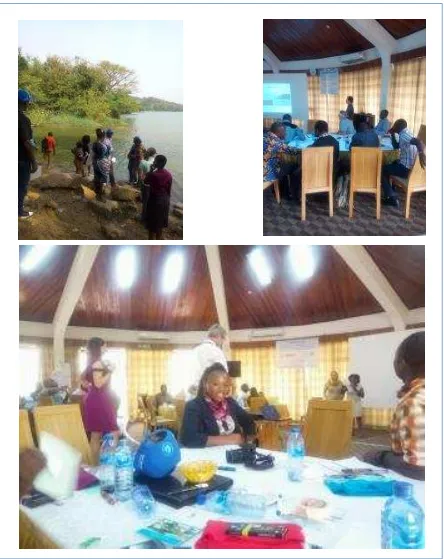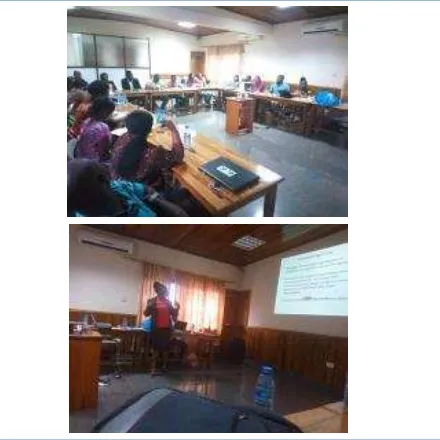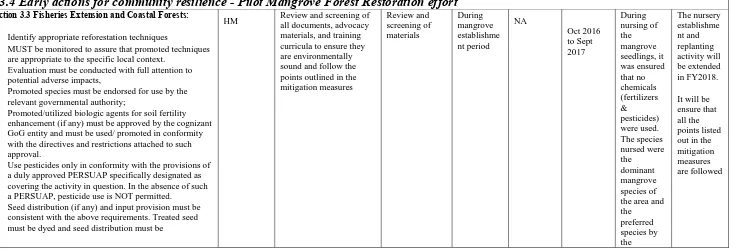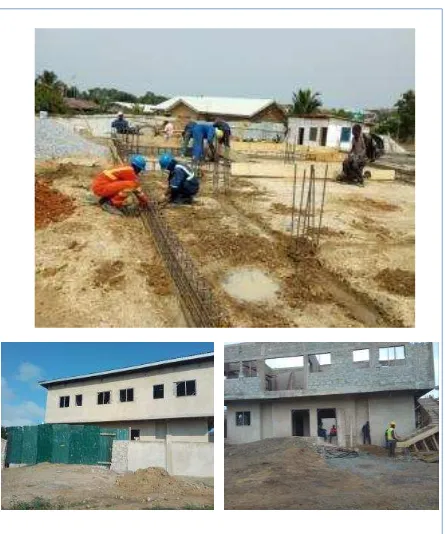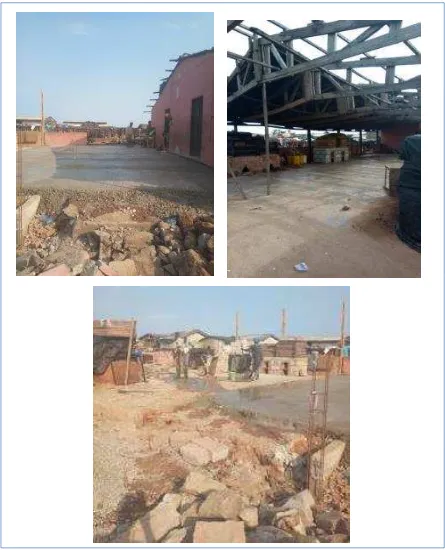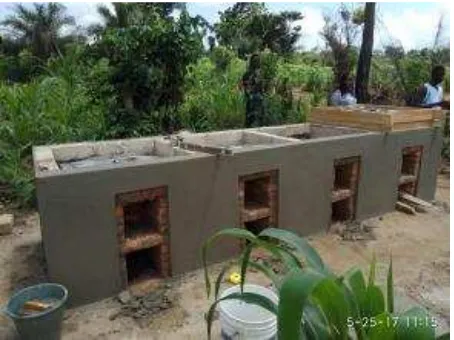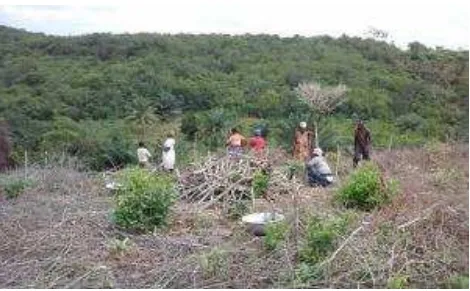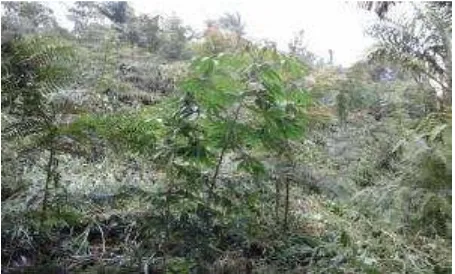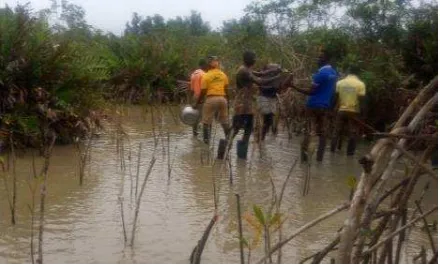SUSTAINABLE FISHERIES
MANAGEMENT PROJECT (SFMP)
Environmental Mitigation and
Monitoring Annual Report
This publication is available electronically in the following locations:
The Coastal Resources Center
http://www.crc.uri.edu/projects_page/ghanasfmp/
Ghanalinks.org
https://ghanalinks.org/elibrary
search term: SFMP
USAID Development Clearing House
https://dec.usaid.gov/dec/content/search.aspx
search term: Ghana SFMP
For more information on the Ghana Sustainable Fisheries Management Project, contact:
USAID/Ghana Sustainable Fisheries Management Project
Coastal Resources Center
Graduate School of Oceanography
University of Rhode Island
220 South Ferry Rd.
Narragansett, RI 02882 USA
Tel: 401-874-6224 Fax: 401-874-6920 Email:
[email protected]
Citation: Owusu, A. A. (2017). Environmental Mitigation and Monitoring Annual Report,
October 1, 2016
–
September 2017. The USAID/Ghana Sustainable Fisheries
Management Project (SFMP). Narragansett, RI: Coastal Resources Center,
Graduate School of Oceanography, University of Rhode Island and Hen Mpoano.
GH2014_PGM194_HM_CRC. 23 pp.
Authority/Disclaimer:
Prepared for USAID/Ghana under Cooperative Agreement (AID-641-A-15-00001), awarded
on October 22, 2014 to the University of Rhode Island, and entitled the USAID/Ghana
Sustainable Fisheries Management Project (SFMP).
This document is made possible by the support of the American People through the United
States Agency for International Development (USAID). The views expressed and opinions
contained in this report are those of the SFMP team and are not intended as statements of
policy of either USAID or the cooperating organizations. As such, the contents of this report
are the sole responsibility of the SFMP team and do not necessarily reflect the views of
USAID or the United States Government.
Detailed Partner Contact Information:
USAID/Ghana Sustainable Fisheries Management Project (SFMP)
10 Obodai St., Mempeasem, East Legon, Accra, Ghana
Telephone: +233 0302 542497 Fax: +233 0302 542498
Maurice Knight
Chief of Party [email protected]
Kofi Agbogah
Senior Fisheries Advisor [email protected]
Nii Odenkey Abbey Communications Officer [email protected]
Bakari Nyari
Monitoring and Evaluation Specialist [email protected]
Brian Crawford
Project Manager, CRC
[email protected]
Justice Odoi
USAID Administrative Officer Representative [email protected]
Kofi.Agbogah
[email protected]
Stephen Kankam
[email protected]
Hen Mpoano
38 J. Cross Cole St. Windy Ridge
Takoradi, Ghana
233 312 020 701
Andre de Jager
[email protected]
SNV Netherlands Development Organisation
#161, 10 Maseru Road,
E. Legon, Accra, Ghana
233 30 701 2440
Donkris Mevuta
Kyei Yamoah
[email protected]
Friends of the Nation
Parks and Gardens
Adiembra-Sekondi, Ghana
233 312 046 180
Peter Owusu Donkor
Spatial Solutions
[email protected]
#3 Third Nautical Close,
Nungua, Accra, Ghana
233 020 463 4488
Thomas Buck
[email protected]
SSG Advisors
182 Main Street
Burlington, VT 05401
(802) 735-1162
Victoria C. Koomson
[email protected]
CEWEFIA
B342 Bronyibima Estate
Elmina, Ghana
233 024 427 8377
Lydia Sasu
[email protected]
DAA
Darkuman Junction, Kaneshie Odokor
Highway
Accra, Ghana
233 302 315894
Gifty Asmah
[email protected]
Daasgift Quality Foundation
Headmaster residence, Sekondi College
Sekondi, Western Region, Ghana
233 243 326 178
For additional information on partner activities:
CRC/URI:
http://www.crc.uri.edu
CEWEFIA:
http://cewefia.weebly.com/
DAA:
http://womenthrive.org/development-action-association-daa
Daasgift:
https://www.facebook.com/pages/Daasgift-Quality-Foundation-FNGO/135372649846101
Friends of the Nation:
http://www.fonghana.org
Hen Mpoano:
http://www.henmpoano.org
ACRONYMS
BEO
Bureau Environmental Officer
CEWEFIA
Central and Western Region Fishmongers Improvement Association
CFR
Code of Federal Regulations
CSLP
Coastal Sustainable Landscape Project
CRC
Coastal Resource Center
CSLP
Coastal Sustainable Landscape Project
DAA
Development Action Association
DFTC
DAA Fisheries Training Center
ECO
Environmental Compliance Officer
ESDM
Environmentally Sound Design & Management
EIA
Environmental Impact Assessment
EMMP
Environmental Mitigation and Monitoring Plan
ESDM
Environmentally Sound Design and Management
FCMCBSP
Fisheries and Coastal Management Capacity Building Support Project
FY
Fiscal Year
HM
Hen Mpoano
IEE
Initial Environmental Examination
IP
Implementing Partners
MEO
Mission Environmental Officer
REA
Regional Environmental Advisor
SFMP
Sustainable Fisheries Management Project
SMEs
Small and Medium Enterprises
SNV
Netherlands Development Organization
UCC
University of Cape Coast
URI
University of Rhode Island
TABLE OF CONTENTS
CONTENTS
ACRONYMS ... iii
TABLE OF CONTENTS ... iv
LIST OF FIGURES ... iv
LIST OF TABLES ... iv
OVERVIEW ... 1
Inspection and Regular Monitoring ... 1
USAID Environmental Compliance and Environmentally Sound Design and Management
(ESDM) Training workshop ... 1
Environmental Compliance training for SFMP and other USAID Implementing Partners .. 3
ENVIRONMENTAL MITIGATION AND MONITORING TABLE... 4
PICTURES FROM MONITORING ACTIVITIES ... 13
LIST OF FIGURES
Figure 1 Picture collage from the Environmental Compliance training workshop at
Akosombo ... 2
Figure 2 Picture collage from the Environmental Compliance training for partners in
Takoradi ... 3
Figure 3 DAA fisheries training center ... 13
Figure 4 CEWEFIA fisheries training center at Elmina in the Central Region ... 14
Figure 5 Two double demonstration units at Tema New Town ... 15
Figure 6 Two double unit smokers at Ejisu-Kumasi (30%/70%) ... 15
Figure 7 A demonstration oven at Keta ... 16
Figure 8 CEWEFIA woodlot plantation site at Anlo ... 16
Figure 9 CEWEFIA woodlot plantation site at Anlo, Scene 2 ... 17
Figure 10 CEWEFIA woodlot plantation site at Anlo, Scene 3 ... 17
Figure 11 Mangrove nursery establishment and replanting site at Ankobra ... 18
Figure 12 Mangrove nursery establishment and replanting site at Ankobra, Scene 2 ... 18
OVERVIEW
Environmental Compliance is a mandatory requirement for all USAID-funded programs, to
ensure project activities do not have significant impact on the environment. USAID
Implementing Partners are obligated to consider throughout the life of project, environmental
impacts arising from its activities.
During the FY 2017 of the SFMP, All USAID environmental requirements laid down in the
project Environmental Mitigation and Monitoring Plan (EMMP) were complied with to
ensure no significant impact on the environment from activity implementation.
Inspection and Regular Monitoring
There were follow up monitoring visits to the DAA fisheries training center and sites where
improved fish smoking ovens were constructed. As at the end of FY 2017, the training center
had not been completed as planned. This has been attributed to the delay in signing the
addendum of the contract.
The site for the CEWEFIA Fisheries Center at Elmina in the Central Region was also
inspected and the necessary protocols developed for monitoring its construction. The
contractor was taken through the protocols to ensure the construction is in compliance with
USAID environmental procedures. Although there was delay in the construction activities,
construction of the CEWEFIA fisheries center is progressing steadily after its commencement
in July.
Environmental mitigation and monitoring forms were prepared for SNV, DAA and
CEWEFIA for monitoring their activities.
USAID Environmental Compliance and Environmentally Sound Design and
Management (ESDM) Training workshop
In January, 2017, the Environmental Compliance officer and 4 other officers from selected
SFMP partners benefited from a training of trainers workshop organized by USAID. The
five-day training workshop on Environmental Compliance and Environmentally Sound
Design & Management (ESDM) was organized for USAID/Ghana and West Africa staff and
partners in Akosombo to strengthen environmentally sound design and management of
USAID funded activities. (See Figure 1)
This training was highly useful since participants were exposed to the USAID environmental
compliance procedures and given an overview of environmentally sound and management
principles, USAID environmental compliance regulations and procedures and skill in
Environmental Impact Assessment (EIA). The combined approach of classroom training and
field exercises provided the potential trainers practical skills in the development of
This training workshop is a direct outcome of the Environmental Compliance and
Environmentally Sound Design and Management (ESDM) Trainer of Trainers workshop in
Akosombo in January 2017. (See Figure 1).
Environmental Compliance training for SFMP and other USAID Implementing
Partners
Based on recommendations that came up during the training, a two-day Environmental
Compliance training workshop was organized to train personnel working on the SFMP,
Coastal Sustainable Landscape Project (CSLP) and the University of Cape Coast Fisheries
and Coastal Management Capacity Building Support Project (FCMCBSP).
Beneficiaries of the ToT, led by the Environmental Compliance officer of SFMP, facilitated
this SFMP organized training workshop. (See Figure 2) Eighteen participants from SFMP
partner organizations, CSLP
and University of Cape Coast’s Fisheries and Coastal
Management Capacity Building Support Project were provided fundamental skills in the
development of USAID Initial Environmental Examination (IEE), Environmental Impact
Assessment (EIA) and EMMP. These officers are now more environmentally aware in
project implementation and monitoring.
ENVIRONMENTAL MITIGATION AND MONITORING TABLE
Most activities that partners implementing had negative determination with conditions. Activities conducted in the FY 2017 that had conditions and
required monitoring and /or mitigation plans are included in the table below
Table 1 Environmental Mitigation and Monitoring Results
Mitigation Measure
Responsi-ble Party
Monitoring Scheme
Estimated cost
Monitoring Log
Indicators Data source/
method How often Date Result Follow-up
Activity 4.3 Integrated Community Fisheries Management and Resilience Plans for the Ankobra River Estuarine
and Mangrove Ecosystem
4.3.4 Early actions for community resilience - Pilot Mangrove Forest Restoration effort
Section 3.3 Fisheries Extension and Coastal Forests: Identify appropriate reforestation techniques
MUST be monitored to assure that promoted techniques are appropriate to the specific local context.
Evaluation must be conducted with full attention to potential adverse impacts,
Promoted species must be endorsed for use by the relevant governmental authority;
Promoted/utilized biologic agents for soil fertility enhancement (if any) must be approved by the cognizant GoG entity and must be used/ promoted in conformity with the directives and restrictions attached to such approval.
Use pesticides only in conformity with the provisions of a duly approved PERSUAP specifically designated as covering the activity in question. In the absence of such a PERSUAP, pesticide use is NOT permitted.
Seed distribution (if any) and input provision must be consistent with the above requirements. Treated seed
HM Review and screening of all documents, advocacy materials, and training curricula to ensure they are environmentally sound and follow the points outlined in the mitigation measures
Review and screening of materials nursing of the mangrove seedlings, it was ensured that no The species nursed were the dominant mangrove species of the area and the preferred
The nursery establishme nt and replanting activity will be extended in FY2018.
Mitigation Measure Responsi-ble Party
Monitoring Scheme
Estimated cost
Monitoring Log
Indicators Data source/
method How often Date Result Follow-up
accompanied by education regarding appropriate handling and non‐edibility.
Demonstration and extension activities may not use/promote genetically modified cultivars. Such support can only be undertaken in conformity with
USAID’s biosafety procedures and requires an
associated amendment to this IEE.
Integrate significant stakeholder consultation, including customary users of resources
community (Rhizophora and Avicenia Sp)
Activity 4.4
Integrated Community
Fisheries Management for the Pra
Activity 4.4.1 Training of youth and women on woodlot management/maintain the woodlot plantation in Anlo
IEE Section 3.3 Fisheries Extension/3a. Institutional strengthening, training/TA / 3b-Fisheries:
During training of the youth and women on woodlot management activities, there should be integration and promotion of general awareness of the environmental, health and safety risks presented by unsustainable use of woodlots, reforestation, tree plantations, fishing and coastal economic activities, and appropriate choices and measures to manage these risks as rooted in appropriate land mgt. plans.
Fisheries chapter of USAID’s Sector Environmental Guidelines ((http://www.usaidgems.org/sectorGuidelines.
htm).
CEWEFIA Review and screen alldocuments, advocacy materials, and training curricula to ensure that they are environmentally sound and follow the points outlined in the mitigation measures
Reviewing and screening of materials
When trainings are provided and training curricula are developed
NA 2/5/2017
11/5/2017 Training curricula
Mitigation Measure Responsi-ble Party
Monitoring Scheme
Estimated cost
Monitoring Log
Indicators Data source/
method How often Date Result Follow-up
Activity
4.5 Value Chain Improvements
Activity
4.5.4 Training of MSMEs in fish processing business development in Greater Accra
IEE Section 3.3 Fisheries Extension/3a. Institutional strengthening, training/TA/ 3b-Fisheries:
During training of MSME’s in fish processing business development, there should be integration and promotion of general awareness of the environmental, health and safety risks presented by unsustainable use of woodlots,
reforestation, tree plantations, fishing and coastal economic activities, and appropriate choices and measures to manage these risks as rooted in appropriate land mgt. plans.
Fisheries chapter of USAID’s Sector Environmental Guidelines ((http://www.usaidgems.org/sectorGuidelines.
htm).
SNV Review and screening of all documents, advocacy materials, and training curricula to ensure that they are environmentally sound and follow the points outlined in the mitigation measures
Review and screening of materials
When trainings are provided and training curricula are developed
NA 8/12/2016
25/4/2017
Reviewed design for IEC ally sound concepts
25/07/2017 Design for new IEC materials were also reviewed with sound messaging
Activity 4.5.6: Construction of 100 improved stoves in Volta Region Accra region
IEE Section 3.5 Infrastructure: Agricultural plots andnurseries/6.1 rehabilitation or new facilities less than 1000M2.
1. Site Selection
Average slope of less than 5% and is not heavily
forested, in an otherwise undisturbed local ecosystem, or in a protected area.
The site is not within 30m of a permanent or
SNV Field reports during and after construction by the Environmental
Compliance Officer.
Mitigation Measure Responsi-ble Party
Monitoring Scheme
Estimated cost
Monitoring Log
Indicators Data source/
method How often Date Result Follow-up
2. Construction
IPs must desist from extracting fill, sand or gravel
from waterways or ecologically sensitive areas
IPs must identify and implement any feasible
measures to increase the probability that forest products like timber are procured from legal, well‐ managed sources.
Construction must be managed so that no standing water on the site more than 4 days;
3.Refurbishments of drying shed and the training on use and maintenance of the smoking ovens
IP shall create awareness among users on the environmental damage of unsustainable use of grown woodlots
Provide personal safety equipment to all workers (i.e. hard hats, goggles, steel-toed boots, gloves, dust masks).
4. Safety and health • The contractor will:
Be required to have a Health and Safety Plan.
Be required to train the construction staff on the Health and Safety Plan.
Provide training on proper use of equipment.
Provide personal safety equipment to all workers (i.e. hard hats, goggles, steel-toed boots, gloves, dust masks).
Provide firefighting equipment/measures.
Provide medical services (access to a first aid kit).
24&25/05/ 2017
25/10 /2017
24 &25/08/ 2017
Monitored 3 double Ahotor ovens in Kumasi. Some level of bush was cleared, but not a
Monitored a demo oven of retrofitted Morison stoves in the
Mitigation Measure Responsi-ble Party
Monitoring Scheme
Estimated cost
Monitoring Log
Indicators Data source/
method How often Date Result Follow-up aspect for the builder.
Activity 4.5.7: Training of Trainers on stove use
During training activities, there should be integration andpromotion of general awareness of the environmental, health and safety risks presented by unsustainable use of woodlots, reforestation, tree plantations, fishing and coastal economic activities, and appropriate choices and measures to manage these risks as rooted in appropriate land management plans.
Fisheries chapter of USAID’s Sector Environmental Guidelines
(http://www.usaidgems.org/sectorGuidelines.htm).
SNV Review and screening of all documents, advocacy materials, and training curricula to ensure that they are environmentally sound and follow the points outlined in the mitigation measures
Review and screening of materials
When trainings are provided and training curricula are developed
NA 11/10/2016 Reviewed training
Activity 4.5.14: Construction of DAA Fisheries Training Center
IEE Section 3.5 Infrastructure: Agricultural plots andnurseries/6.1 rehabilitation or new facilities less than 1000M2
1. During construction, IPs must ensure that contractors:
ECO, SNV, DAA
Completed review and screening form to ensure that the construction activity is
Environmental and monitoring forms for the construction of
Monthly visits during construction through the USAID
Mitigation Measure Responsi-ble Party
Monitoring Scheme
Estimated cost
Monitoring Log
Indicators Data source/
method How often Date Result Follow-up
Identify and implement any feasible measures to increase the probability that forest products like timber are procured from legal, well‐managed sources.
Minimize the use of heavy machines
Construction must be managed so that no standing water on the site persists more than 4 days;
Prevent dumping of hazardous materials. Burn waste materials that are not reusable/readily recyclable, do not contain heavy metals and are flammable
Concentrate noisiest types of work into as short a period as possible, and during least disruptive times of the day. Take measures to keep dust to a minimum
Bore hole to be dug for domestic use should be tested for arsenic, coliform, nitrates and nitrites. 2. No lead‐based paint shall be used. When lead‐free paint
is used, it will be stored properly so as to avoid
accidental spills or consumption by children; empty cans will be disposed of in an environmentally safe manner away from areas where contamination of water sources might occur; and the empty cans will be broken or punctured so that they cannot be reused as drinking or food containers.
3. Waste handling equipment and infrastructure. USAID
intervention must result in the facilities’ possessing
adequate provision for handling the wastes they may generate; including human wastes.
4. In terms of safety and health risks;
The contractor that will be responsible for the rehabilitation works will be required to have a Health & Safety Plan.
The contractor will train the construction staff on the Health & Safety Plan.
measures in the IEE/EMMP
Field reports of physical inspection during and after construction by the Env. Comp. Officer
Field Reports during activities do not have Health and Safety Policy, and provided
PPE’s for
Mitigation Measure Responsi-ble Party
Monitoring Scheme
Estimated cost
Monitoring Log
Indicators Data source/
method How often Date Result Follow-up
The contractor will be required to provide training on proper use of equipment.
The contractor will provide personal safety equipment to all workers (i.e. hard hats, goggles, steel-toed boots, gloves, dust masks).
The contractor will provide firefighting equipment/measures.
The contractor will ensure proper storage of building materials.
The contractor provides medical services (access to a first aid kit).
Prevent access to site at all times by unauthorized persons intrusion of people and animals Constructio n was advised on how best to manage and place tools to ensure safety.
Activity 4.5.17 Two- day Training on Hygienic Fish Handling
IEE Section 3.3 Fisheries Extension/3a. Institutionalstrength., training/TA / 3b-Fisheries:
During training activities, there should be integration and promotion of general awareness of the environmental, health and safety risks presented by unsustainable use of woodlots, reforestation, tree plantations, fishing and coastal economic activities, and appropriate choices and measures to manage these risks as rooted in appropriate land management plans.
Fisheries chapter of USAID’s Sector Environmental Guidelines ((http://www.usaidgems.org/sectorGuideli nes.htm).
CEWEFIA Review and screening of all documents, advocacy materials, and training curricula to ensure that they are environmentally sound and follow the points outlined in the mitigation measures
Review and screening of materials
Mitigation Measure Responsi-ble Party
Monitoring Scheme
Estimated cost
Monitoring Log
Indicators Data source/
method How often Date Result Follow-up
Activity 4.5.20: CEWEFIA FISHERIES TRAINING CENTER
IEE Section 3.5 Infrastructure: Agricultural plots andnurseries/6.1 rehabilitation or new facilities less than 1000M2
During construction, IPs must ensure that contractors:
Desist from extracting fill, sand or gravel from waterways or ecologically sensitive areas
Identify and implement any feasible measures to increase the probability that forest products like timber are procured from legal, well‐managed sources.
Minimize the use of heavy machines
Construction must be managed so that no standing water on the site persists more than 4 days;
Prevent dumping of hazardous materials. Burn waste materials that are not reusable/readily recyclable, do not contain heavy metals and are flammable
Concentrate noisiest types of work into as short a period as possible, and during least disruptive times of the day. Take measures to keep dust to a minimum
Bore hole to be dug for domestic use should be tested for arsenic, coliform, nitrates and nitrites.
No lead‐based paint shall be used. When lead‐free paint is used, it will be stored properly so as to avoid
accidental spills or consumption by children; empty cans will be disposed of in an environmentally safe manner away from areas where contamination of water sources might occur; and the empty cans will be broken or punctured so that they cannot be reused as drinking or food containers.
Waste handling equipment and infrastructure. USAID
intervention must result in the facilities’ possessing
adequate provision for handling the wastes they may generate; including human wastes.
ECO, CEWEFIA
Completed review and screening form to ensure that the construction activity is
environmentally sound and follow the points outlined in the mitigation measures in the
IEE/EMMP
Field reports of physical inspection during and after construction by the Env. Comp. Officer
Environmental and monitoring forms for the construction of the CEWEFIA Fisheries Training Center Field Reports during and immediately
Mitigation Measure Responsi-ble Party
Monitoring Scheme
Estimated cost
Monitoring Log
Indicators Data source/
method How often Date Result Follow-up
In terms of safety and health risks;
The contractor that will be responsible for the rehabilitation works will be required to have a Health & Safety Plan.
The contractor will train the construction staff on the Health & Safety Plan.
The contractor will be required to provide training on proper use of equipment.
The contractor will provide personal safety equipment to all workers (i.e. hard hats, goggles, steel-toed boots, gloves, dust masks).
The contractor will provide firefighting equipment/measures.
The contractor will ensure proper storage of building materials.
The contractor provides medical services (access to a first aid kit).
Prevent access to site at all times by unauthorized persons
PICTURES FROM MONITORING ACTIVITIES
Figure 5 Two double demonstration units at Tema New Town
Figure 7 A demonstration oven at Keta
\
Figure 9 CEWEFIA woodlot plantation site at Anlo, Scene 2
